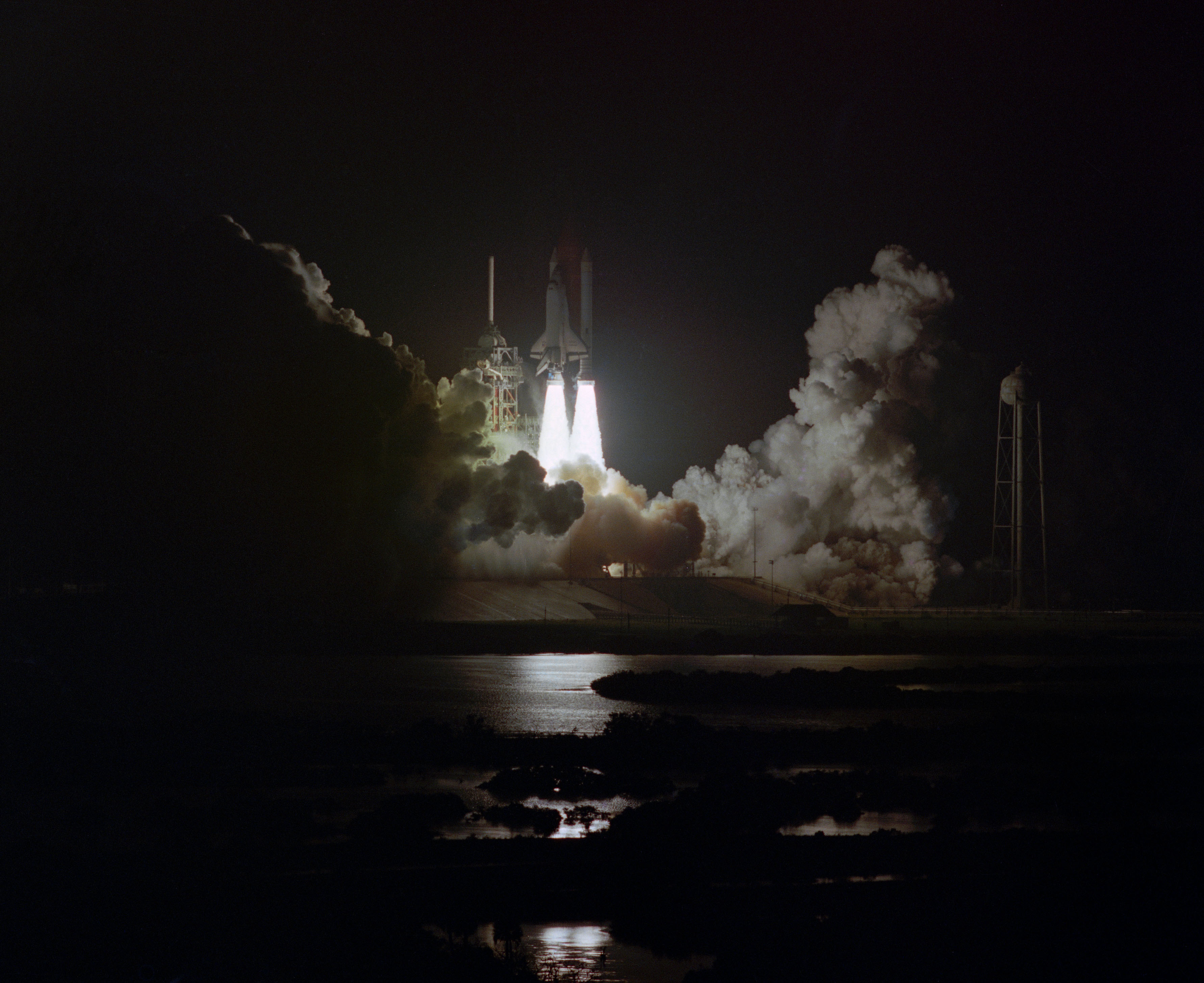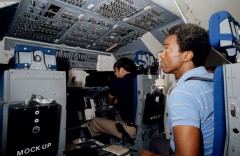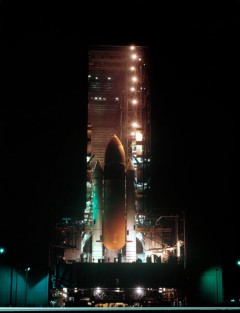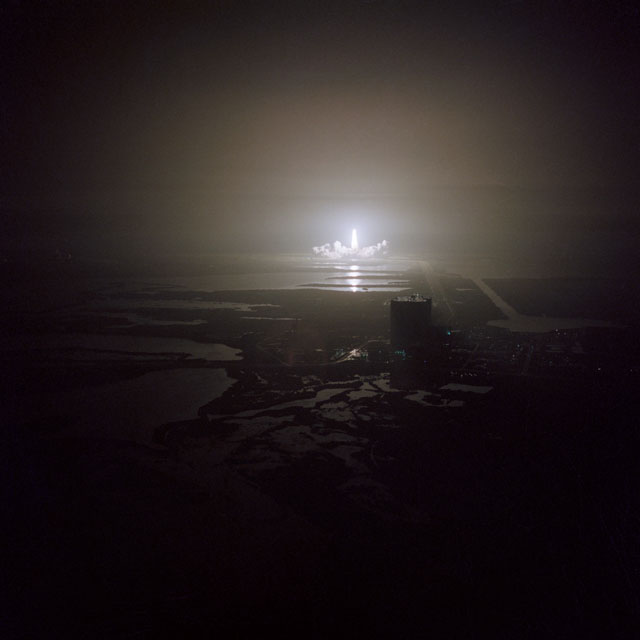
At about midnight on the rainy evening of 30 August 1983, the adventure began for Guy Bluford, NASA’s first African-American astronaut. Together with his four STS-8 crewmates—Dick Truly, Dan Brandenstein, Dale Gardner, and Bill Thornton—he left the Operations and Checkout Building at the Kennedy Space Center, Fla., bound for Pad 39A and a ride into space aboard Challenger. For Bluford, the 8.5-minute climb to orbit, and the six days in space that would follow, proved to be one of the highlights of his life … so much so that he found himself laughing, chuckling, and giggling almost uncontrollably throughout the ascent.
Tucked into the shuttle’s payload bay for STS-8 was an Indian communications satellite, Insat-1B, which had netted NASA $4 million in fees and which Bluford and Gardner were scheduled to deploy a few hours into the mission. Unfortunately, another payload—the second Tracking and Data Relay Satellite (TDRS-B), whose descendents remain in operational service today—had been deleted from the STS-8 roster as a result of an Inertial Upper Stage (IUS) booster failure soon after the TDRS-A launch on STS-6 in April 1983.
Had TDRS-B remained aboard Challenger, alongside Insat-1B, for the STS-8 mission, it would have been the heaviest cargo complement yet ferried into orbit at over 63,000 pounds. “There was very little weight-growth margin,” Bluford later told the NASA oral historian. “During the training, Dale and I made several trips to Boeing Aircraft Corporation in Seattle, Wash., to learn about the IUS. We were becoming well versed in the operation of the IUS when it malfunctioned on STS-6 and, because of that, NASA decided not to fly the TDRS on our flight until after the mishap was investigated.”

The presence of two of these communications and data relay platforms in geostationary orbit—one at 171 degrees West longitude, above the central Pacific Ocean to the south of Hawaii, and another just off the Atlantic coast of Brazil, at 41 degrees West—was highly desirable to support the first Spacelab research flight in late 1983. A third orbital “spare” (TDRS-C) was then to be launched on STS-12 in March 1984 and placed over the equator at 79 degrees West. However, by the end of May 1983, as investigators got to grips with finding out why the IUS had failed to inject TDRS-A into its 22,600-mile operational orbit, NASA opted not to risk launching another one until the problems were resolved. Efforts were already underway to raise TDRS-A into its correct “slot,” at the expense of using two thirds of its valuable hydrazine fuel. As late as mid-July 1983, Flight International noted that NASA was hopeful that TDRS-A could be recovered in time to support the first Spacelab mission and the second satellite, TDRS-B, was provisionally remanifested onto STS-12.
In place of TDRS-B would fly an unusual contraption called the Payload Flight Test Article (PFTA). According to NASA’s shuttle manifest of April 1982, this had been scheduled to fly aboard STS-16 in June 1984, but within a month of the return of STS-6 it had been moved forward to STS-8. Weighing 8,500 pounds, it looked like a giant dumb bell structure—a pair of “wheels,” connected by a central axle—to evaluate the performance and handling characteristics of the shuttle’s Canadian-built Remote Manipulator System (RMS) mechanical arm. The PFTA was constructed from aluminum and stainless steel and equipped with four grapple fixtures; two of which would be used on STS-8. Its aim was to acquire “real world” data and develop crew expertise on RMS elbow, wrist, and shoulder joint reactions.
Yet it was the deployment and tracking requirements of their other payload—the Indian National Satellite, Insat-1B—that brought about one of the most historic features of the mission: the first shuttle night launch, 30 years ago this week. “One of the neat things about it was that it was going to be a night launch and a night landing,” recalled Dan Brandenstein in his NASA oral history. “What drove that was we were launching Insat and, to get it in the proper place, we worked the problem backwards. They wanted the satellite ‘here,’ so then we had to go back down our orbital mechanics and it meant we had to launch at night. The fact we launched at night meant that we would end up landing at night. Dick and I had both done night carrier landings and, judging from the way the shuttle flies and doing that at night, we both looked at each other and said, ‘Oooh. This is going to be interesting!’ We got very much involved in developing a lighting system to enable us to safely land at night.”

This nocturnal launch had been simulated on the ground. “We concentrated on flying night launches and night landings in a darkened simulator,” Bluford recalled. “We learned to set our light levels low enough in the cockpit that we could maintain our night vision, and I had a special lamp mounted on the back of my seat so that I could read the checklist in the dark. The only thing that wasn’t simulated was the lighting associated with the Solid Rocket Booster ignition and the firing of the pyros for SRB and External Tank separation.”
When Truly, Brandenstein, Gardner, and Bluford were assigned to STS-8 in April 1982, it was intended for them to remain a four-man crew. Then, in December 1982, the decision was taken to add a pair of physician-astronauts to STS-7 and STS-8, and Truly’s crew wound up gaining Dr. Bill Thornton, who secured his own place of history by becoming the oldest human being yet to fly into space, aged 54. After 16 years as an astronaut, it was a joy for him to receive his first flight assignment. His wife, Jennifer, described Christmas 1982 as his happiest since joining NASA … and as the astronaut office’s foremost expert on “space sickness” Thornton recalled that STS-8 “was the first and probably only flight that an investigator was ever allowed to make his own selection of experiments … and fly with it.”
On a lighter note, Thornton’s assignment had actually led to the creation of an extra, unofficial crew patch. Historically, astronauts avoided doctors like the plague, remarking that there were only two ways a pilot could emerge from a consultation: either “fine” or “grounded.” None of the STS-8 astronauts was at risk of being grounded by Thornton, but his experiments, which included a series of blood tests on himself, resulted in a mission patch featuring his bespectacled eyes peering at a cluster of four pairs of frightened eyes in Challenger’s flight deck. This good-natured “fear” of the good doctor continued into space during a telecast in which Thornton explained the purpose of his medical tests to his terrestrial audience. At the end of the telecast, Dick Truly quipped that the rest of the crew were now fed up with this “chamber of horrors” and picked up a hammer, floated across the middeck, and revealed Thornton being restrained to a bulkhead with grey tape. “His three colleagues,” wrote space historians Dave Shayler and Colin Burgess in their book NASA’s Scientist-Astronauts, “each wielded knives, wrenches, pliers, and hammers and, as the screen faded, a muffled scream from the good doctor was heard to close the telecast … ”
Humor aside, it was with an air of trepidation that Truly led his men into a bewildering glare of media lights in the opening minutes of 30 August 1983. In the final week before launch, it became necessary for them to shift their sleep patterns into the daytime hours. “It took us about a week to get comfortable with that,” recalled Bluford. “Some of us slept at home, while others slept in the crew quarters … in Houston. We ate food prepared at the center and practiced in the simulators at night. About three to four days before launch, we flew to the Cape for the final launch countdown. On 29 August, we were awakened at 10 p.m. We had breakfast and suited up for the mission, then headed downstairs for the van ride to the launch pad. I noticed it was raining. There was lightning in the area and there was some concern expressed by the launch control center about our safety as we proceeded out to the pad. Finally, they left it up to Dick to decide if it was safe for the crew to go to the pad. He made the decision for us to proceed and went out to Challenger.
“As we climbed into the vehicle and completed our pre-flight checks,” Bluford continued, “the rain began to subside and the clouds began to clear away. The ride into orbit was really exciting! We had darkened the cockpit to prepare for liftoff; however, when the [Solid Rocket Boosters] ignited, they turned night into day inside! Whatever night vision we hoped to maintain, we lost right away at liftoff.” Launch occurred at 2:32 a.m., about 17 minutes into a half-hour “window,” due to the thunderstorms in the area.

Seated behind and between Truly and Brandenstein, as STS-8’s flight engineer, it was Bluford’s task to check off each stage of the violent climb to orbit. Next to him on the flight deck, literally shoulder to shoulder, and directly behind Brandenstein, was Dale Gardner. Bill Thornton sat alone in the darkened, locker-studded middeck. From his vantage point, the doctor had little to see: the only window was a small circular one in the side hatch, although, craning his neck, he could see “upwards” into the flight deck and through the overhead windows. At the instant of liftoff, Thornton recalled, the sensation was like “taking a fast ride on the London Underground.” From his perspective, all was dark during the first two minutes of ascent, but as soon as Challenger shed her twin Solid Rocket Boosters (SRBs), the entire cockpit was eerily lit up.
Upstairs, Gardner’s main view was through the overhead windows, and what he saw worried him sufficiently to call Brandenstein over the intercom. As the pilot, one of Brandenstein’s key roles during ascent was to monitor the performance of main engines. “Obviously, Dick Truly and I were up front, watching the instruments,” recalled Brandenstein, “and Dale was looking back over his head out the [overhead] window and back at the ground. At night, he could see how it lit everything up. During the first stage, it was really bright, because we had the boosters going. In fact, from the front cockpit, looking out, it was like we were inside a fire, because we didn’t really see the flame, but we did see the reflection and the light.”
They were not far into the ascent when Gardner piped up.
“Dan, how do the engines look?”
“Fine, they look fine,” came Brandenstein’s reply.
Thirty seconds later, Gardner repeated the question. Again, the response was the same.
“I don’t know how many times this happened going uphill,” Brandenstein recalled years later. After entering orbit, he asked Gardner why he had been so concerned. To Gardner’s eyes, the behavior of the main engine exhaust in the rarefied atmosphere had appeared to “flutter,” and this had brought back unpleasant memories of shuttle main engines malfunctioning or exploding on test stands in the late 1970s. “You have a different perspective as you get higher,” Brandenstein told the oral historian. “The air pressure goes way down and you get into a vacuum, so basically what holds your flame real tight is the atmospheric pressure factors in that. When you get outside atmospheric pressure, they expand and flutter a little bit more.”
After STS-8, as the astronauts listened back on their cockpit intercom tapes from ascent, they were puzzled to hear someone laughing all the way into orbit. It was Bluford. Years later, he remembered being so excited by the whole event that his only feeling at the time was not fear, but sheer elation. That elation would be multiplied by the events of the next six days in space, which tomorrow’s history article will continue.
The second part of this article will appear tomorrow.
Want to keep up-to-date with all things space? Be sure to “Like” AmericaSpace on Facebook and follow us on Twitter: @AmericaSpace



